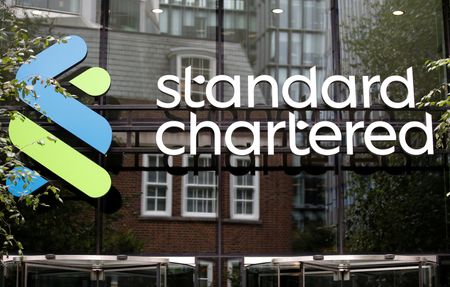By Selena Li and Lawrence White
HONG KONG/LONDON (Reuters) -Standard Chartered (StanChart) reported on Thursday a higher-than-expected 26% jump in first-half pretax profit, driven by growth in the bank’s wealth and markets businesses that benefitted from the Trump-induced global volatility.
The results show progress in CEO Bill Winters’ key goal of growing revenue across its three main business lines of wealth, trading and banking, after spending the first half of his 10-year reign restructuring the bank to slash costs.
London-listed shares of StanChart opened flat, after its Hong Kong shares pared early losses to be down 0.4% by 0713 GMT, outperforming the broader Hong Kong market which was down 1.5%.
The bank’s shares have outperformed Britain’s benchmark FTSE 100 index in recent weeks for the first time since the start of Winters’ tenure.
“My first couple of years here were particularly tough given the amount of restructuring that we felt we needed to do,” Winters told reporters on a conference call, hailing a turnaround at the bank.
“And as I think is the case in most turnaround type stories, it takes a while to demonstrate to the market that the value that is there is really there”.
BOOM IN TRADING, WEALTH
The London-headquartered lender’s pretax profit for the first six months of this year hit $4.38 billion, better than the $3.83 billion analysts had forecast.
Emerging markets-focused StanChart also announced a further $1.3 billion share buyback, and an interim dividend of 12.3 cents a share, its first dividend payment in 2025.
First-half income grew 11%, and the bank, which earns most of its revenue in Asia and Africa, slightly raised its guidance for full-year income, saying it now expected growth to be at the bottom of a 5%-7% range rather than below it.
The trading business, StanChart’s second-biggest revenue driver, registered a 28% jump in operating income to $2.4 billion, propelled by buoyant client trading amid rising market volatility following U.S. President Donald Trump’s trade tariffs.
Wealth management income shot up by 24% as efforts to boost fee revenue paid off with inflows and the number of new accounts rising – with 135,000 new affluent clients joining in the first six months – due to demand for wealth advice amid the market volatility.
The bank has said it will target $200 billion in new assets and double-digit growth in income from its wealth business over the next five years, as part of a wider strategy to shift to higher fee-earning businesses.
CHINA LOSSES AVOIDED
The lender also appeared to dodge the multi-billion dollar China-related write-downs which blighted rival HSBC’s results announced on Wednesday, with StanChart reporting an impairment charge for the first half of $336 million, mainly from its wealth and retail banking unit.
The bank said its exposure to Hong Kong’s troubled commercial real estate sector was $2.1 billion, less than 0.5% of its total book, with provisions rising $34 million in the second quarter of the year to $116 million.
The lender, however, warned that cash constraints on borrowers could lead to more impairments.
StanChart also kept its key performance targets largely unchanged, although the bank’s Chief Risk Officer Sadia Ricke said the risk of “re-escalation in global tariffs” has somewhat moderated.
“Outside tariffs, we remain vigilant in monitoring geopolitical risks across geographies including the Middle East and the resultant impact it could have on certain commodities prices,” she said in a statement.
(Reporting by Selena Li in Hong Kong and Lawrence White in London; Editing by Muralikumar Anantharaman)










